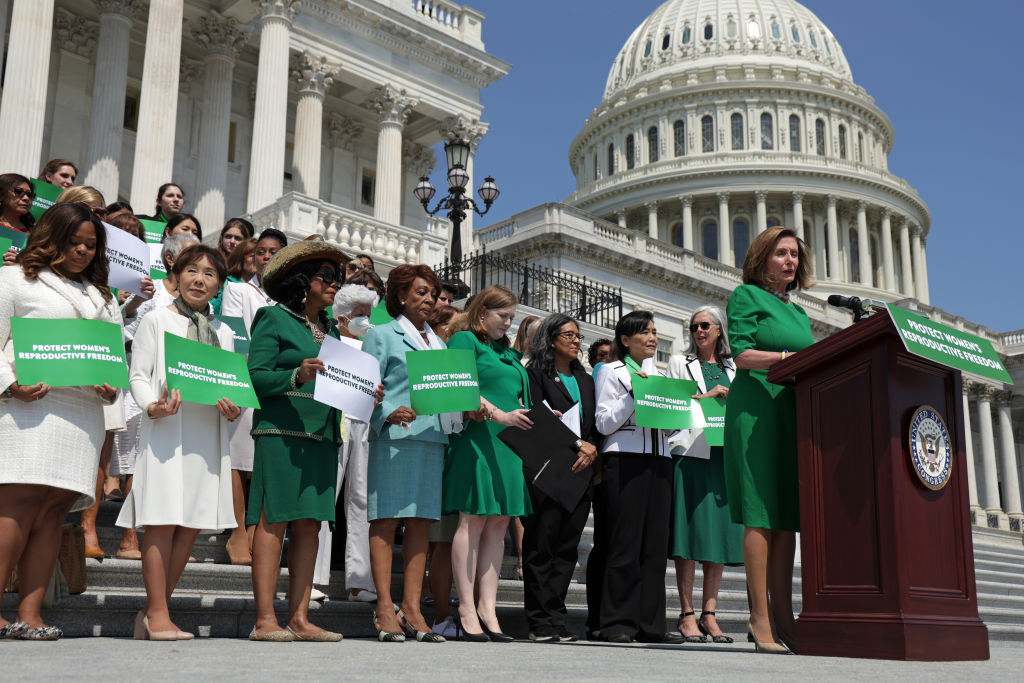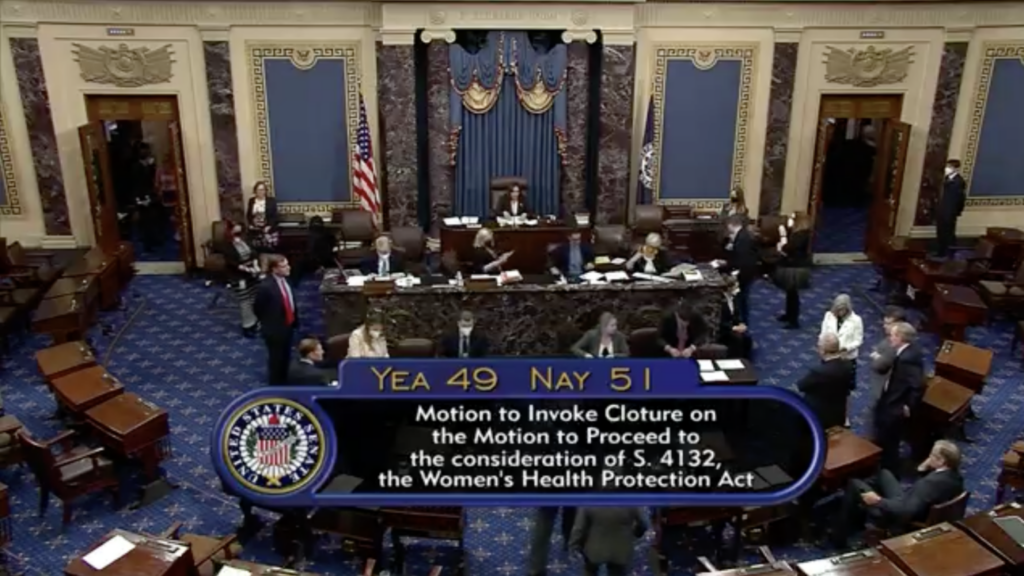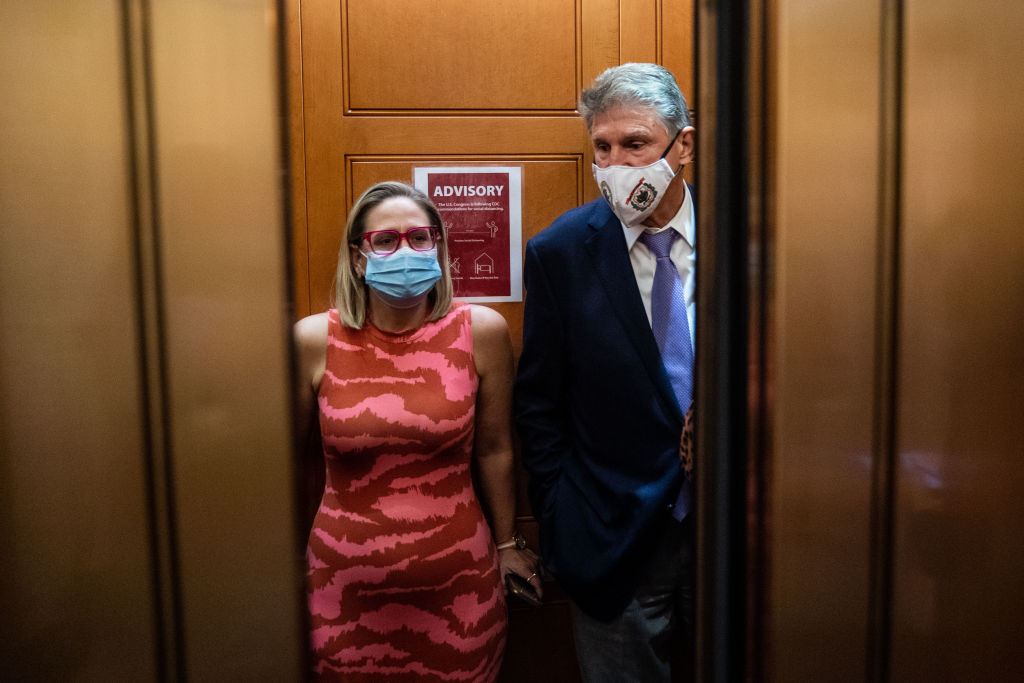A Senate rule prevents the narrow Democratic majority from passing laws to protect women’s rights—for now. Here’s how the midterm elections could change that.

This article originally appeared in Ms.’s Fall 2022 issue. Join the Ms. community today and get the issue delivered straight to your mailbox.
This November, women’s rights and the future of an inclusive and diverse democracy truly are on the ballot. Following the overturning of Roe v. Wade, the Democratic-controlled House of Representatives advanced three bills that would protect access to reproductive healthcare.
- The Ensuring Access to Abortion Act passed on a 223-205 vote, with only three Republican members voting in favor.
- The Women’s Health Protection Act of 2022 passed on a 219-210 vote, with all Republican representatives and anti-abortion Rep. Henry Cuellar (D-Texas) voting against it.
- After Justice Clarence Thomas argued in his concurrence in Dobbs v. Jackson Women’s Health Organization that the Supreme Court should revisit other precedents such as those guaranteeing access to contraception, the House proactively passed the Right to Contraception Act with a 288-195 vote, with only eight Republicans in support.
These bills now need to pass the Senate to become law. But all must overcome Republican-led filibusters to proceed to a vote by the full chamber. Senate Rule XXII requires senators to invoke what is called cloture to end debate and move to a vote. To do that currently requires a 60-vote majority. If the cloture motion is unsuccessful, the bill is killed by the filibuster.
These critical House bills are not even close to meeting the 60-vote threshold, leaving women across the U.S. without adequate legal protections to access reproductive healthcare—and making filibuster reform that much more urgent. The filibuster has a long history of being used as a tool of obstruction to prevent progressive change. Senators have used the filibuster to uphold slavery and later to kill or delay civil rights legislation, such as anti-lynching bills and the Civil Rights Act. Between 1917 and 1994 half of all filibusters were used to block racial equity legislation.
Today, the filibuster stands in the way of proactive government. “It takes the 60-vote threshold to actually legislate affirmatively, to create change and to put things out there that don’t exist currently,” said Tré Easton, deputy director at the Battle Born Collective, a legislative and communications organization advocating for a progressive policy agenda.
By requiring 60 votes to overcome a filibuster, the U.S. Senate has made American democracy subject to the tyranny of minority rule. President James Madison himself warned against giving the minority vast power, stating in Federalist Paper No. 58: “In all cases where justice or the general good might require new laws to be passed, or active measures to be pursued, the fundamental principle of free government would be reversed. It would be no longer the majority that would rule: the power would be transferred to the minority.”
The framers of the U.S. Constitution deeply distrusted supermajority requirements, as imposed by the filibuster, reserving supermajority votes for overriding presidential vetoes, impeaching an officer, ratifying treaties and amending the Constitution.
Caroline Fredrickson, a visiting professor at Georgetown Law and a senior fellow at the Brennan Center for Justice, stressed that the filibuster is not only undemocratic, but also established the Senate as “an institution that is profoundly obstructive to the desires of the vast majority of Americans.”
Budget reconciliation is the only type of legislation that is exempted from the filibuster under current Senate rules. Using this route, Democrats were able to pass major climate change and healthcare policies in August as part of the Inflation Reduction Act of 2022, a reconciliation bill, with a simple majority vote (after finally reaching a deal with Sen. Joe Manchin [D-W.Va.]). All Republicans opposed the measure, which had all Democrats in support and Vice President Kamala Harris breaking the 50-50 tie.
Putting progressive policies into a budget reconciliation measure, therefore, is one option for circumventing the filibuster, but only if the proposed policy is directly or substantially related to the federal budget. Additionally, reconciliation can be used only once or twice per year.
But this is not the only way to avoid a filibuster. Beyond getting rid of the filibuster completely, an effort which could itself be filibustered, senators can use the so-called nuclear option, a procedural maneuver that limits the use of the filibuster on a specific piece of legislation. This is also often referred to as “carving out an exception to the filibuster.”
As explained in a report by the Brookings Institution on filibuster reform, to carve out an exception to the filibuster, the Senate majority leader “would raise a point of order that cloture on [a particular bill] be decided by a simple majority vote, which would be denied by the presiding officer (acting on advice of the parliamentarian). The leader would then appeal the ruling to the Senate, the vote on which, if done in reconsideration of a failed cloture vote, is not subject to debate. The Senate would then vote on the appeal. If the appeal were successful by a simple majority, the new precedent of requiring only a simple majority vote for cloture would prevent the filibuster of [the bill].”
In 2013, Democrats used this option to allow the confirmation of non-Supreme Court federal judicial appointments and executive branch appointments (think cabinet members) with a simple majority vote.
In 2017, Republicans did the same for Supreme Court nominees.
In total, the Senate approved 161 exceptions to the filibuster rule between 1969 and 2014.
Sen. Dianne Feinstein (D-Calif.) stated this summer that she supports a carve-out of the filibuster to pass the Women’s Health Protection Act: “Let me be clear: If it comes down to protecting the filibuster or protecting a woman’s right to choose, there should be no question that I will vote to protect a woman’s right to choose.”
The president, too, supports a carve-out to protect reproductive healthcare—and for voting rights legislation. The Freedom to Vote: John R. Lewis Act was killed by a Republican filibuster in January 2022 after Manchin and Sen. Kyrsten Sinema (D-Ariz.) refused to agree to carve out an exception that would have allowed passage by a majority vote.
Shortly after a draft of the Supreme Court decision to overturn Roe was leaked in May, the Senate tried to pass a version of the Women’s Health Protection Act. The Senate vote failed to clear the 60-vote threshold, with Manchin joining all Republican senators to oppose the bill.
The Senate is an institution that is profoundly obstructive to the desires of the vast majority of Americans.
Caroline Fredrickson

A similar fate awaits a joint resolution to remove the ratification deadline of the Equal Rights Amendment. When Congress originally passed the ERA in 1972, the preamble included an arbitrary clause stating the amendment must meet the 38-state requirement for ratification by 1979, a deadline later extended by Congress to 1982. However, the ERA did not meet the 38-state threshold until Nevada (2017), Illinois (2018) and Virginia (2020) ratified it.
The House already passed the joint resolution on the ERA with bipartisan support and the joint Senate resolution has attracted 51 cosponsors from both sides of the aisle.
“A normal functional legislative body where you have 100 members and 52 members support a thing, you will be able to pass it. But it’s very specifically because of the filibuster [the ERA joint resolution] can’t get to 60 votes,” Easton said.
Likewise, the Respect for Marriage Act, which would provide a federal protection for preexisting marriages of same-sex couples, passed the House with 47 Republicans voting in favor. However, as of August, only five Republican senators are publicly on record in support of the bill, which makes it unlikely to survive a cloture vote.
In July, Senate Democrats tried to pass the Right to Contraception Act via unanimous consent, but Sen. Joni Ernst (R-Iowa) objected, thus killing the bill. Ernst referred to the bill as a “wolf in sheep’s clothing,” and argued erroneously that it would provide funding for “abortion-related providers” like Planned Parenthood.
If it comes down to protecting the filibuster or protecting a woman’s right to choose, there should be no question that I will vote to protect a woman’s right to choose.
Sen. Dianne Feinstein (D-Calif.)
So how likely is filibuster reform?
There is a mythology surrounding the filibuster as a last tool to preserve minority rights and voices in the Senate, along with a romanticized version of how the Senate considers legislation through deliberation.
“It was supposed to be [that] a minority of senators are able to have their voices heard,” Easton said. “And then once that’s sort of been settled, we move to end debate and go to a majority rule for a vote.”
Fredrickson said Republicans have no incentive to reform the filibuster because it “helps them ensure that progressive legislation doesn’t move.”
Some Democrats argue for hanging on to the filibuster because it has preserved policies that were under attack during the Trump presidency, like abortion and birth control access. (And some Republicans may want to reform the filibuster if they retake the majority and capture the White House.) But Easton reminded us, the worst-case scenario has happened through a Supreme Court decision. And it took only 51 votes to confirm the justices, while now it takes 60 votes to undo the damage done.
Democrats need 50 votes to carve out exceptions to the filibuster (with Harris breaking the tie), but Manchin and Sinema have refused to entertain reforms or carve-outs. This makes the midterm races crucial for Democrats, who need to pick up another two senators in support of filibuster reform.

Picking up two seats is important for another reason, according to Easton. Manchin and Sinema’s open opposition to changing the filibuster has given cover to other Democrats who are hesitant about filibuster reform. If the party picks up more seats in the midterms, these Democrats can no longer hide behind Manchin and Sinema. They’ll have to answer where they stand on filibuster reform and how far they are willing to go to advance policies involving fundamental rights—including voting, reproductive autonomy and constitutional equality for women.
Keeping this in mind and with the midterms right around the corner, we’re watching nine races that will determine the makeup of the U.S. Senate. And even if Democrats only need to pick up a net of two new members willing to reform the filibuster, Fredrickson said, “every race is important and any single one of them could make the difference.”
Every race is important and any single one of them could make the difference.
Caroline Fredrickson
Democrats are hoping to flip Senate seats in Pennsylvania, North Carolina, Florida, Ohio and Wisconsin.
Republicans have set their eyes on flipping Georgia, Nevada, New Hampshire and Arizona.
Out of the nine races, Democratic incumbents are defending their seats in Arizona, Georgia, New Hampshire and Nevada—while Republicans hope to hold on to their seats in Ohio, Florida and Wisconsin.
North Carolina and Pennsylvania are the only races for open seats currently held by Republicans. Traditionally, incumbents have a strong advantage over challengers. However, the situation is different during midterms, when both parties need to overcome traditionally low turnout and, in the case of Democrats this year, a president with low approval ratings.
Women candidates are competing in four critical Senate races.
- In Nevada, incumbent Sen. Catherine Cortez Masto (D) is defending her seat against Republican challenger Adam Laxalt.
- In New Hampshire, incumbent Sen. Maggie Hassan (D) will face Republican challenger Donald C. Bolduc.
- In North Carolina, Cheri Beasley, one of only two Black Democratic women nominated to run in a Senate primary in 2022, is now competing against Republican Ted Budd in a race for an open seat.
- In Florida, U.S. Rep. Val Demings (D) is challenging sitting Sen. Marco Rubio (R).
If this summer has shown us anything, it is that from now on, women’s rights hang in a precarious electoral balance.
U.S. democracy is at a dangerous inflection point—from the demise of abortion rights, to a lack of pay equity and parental leave, to skyrocketing maternal mortality, and attacks on trans health. Left unchecked, these crises will lead to wider gaps in political participation and representation. For 50 years, Ms. has been forging feminist journalism—reporting, rebelling and truth-telling from the front-lines, championing the Equal Rights Amendment, and centering the stories of those most impacted. With all that’s at stake for equality, we are redoubling our commitment for the next 50 years. In turn, we need your help, Support Ms. today with a donation—any amount that is meaningful to you. For as little as $5 each month, you’ll receive the print magazine along with our e-newsletters, action alerts, and invitations to Ms. Studios events and podcasts. We are grateful for your loyalty and ferocity.
Up next:





